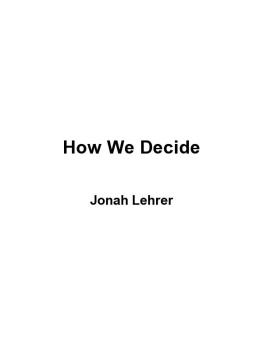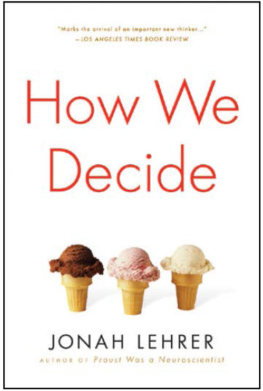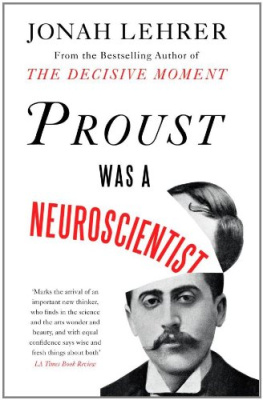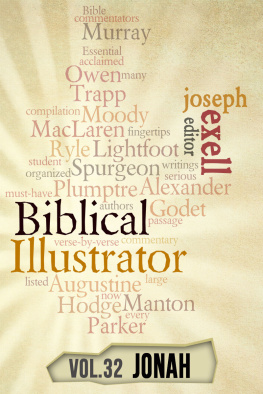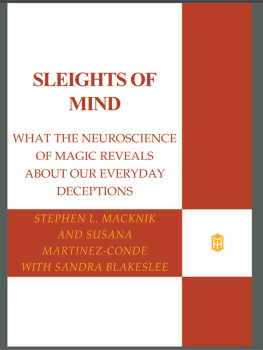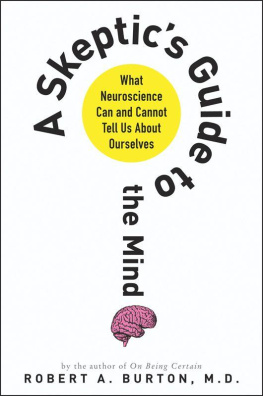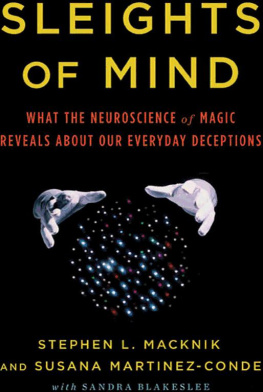HOUGHTON MIFFLIN HARCOURT
BOSTON NEW YORK 2009
Copyright 2009 by Jonah Lehrer
ALL RIGHTS RESERVED
For information about permission to reproduce selections from
this book, write to Permissions, Houghton Mifflin Harcourt
Publishing Company, 215 Park Avenue South,
New York, New York 10003.
www.hmhbooks.com
Library of Congress Cataloging-in-Publication Data
Lehrer, Jonah.
How we decide / Jonah Lehrer.
p. cm.
Includes bibliographical references and index.
ISBN 978-0-618-62011-1
1. Decision making. I. Title.
BF 448. L 45 2009
153.8'3dc22 2008036769
Printed in the United States of America
Book design by Victoria Hartman
DOC 10 9 8 7 6 5 4 3 2 1
To my siblings,
Eli, Rachel, and Leah
Contents
INTRODUCTION
1. The Quarterback in the Pocket
2. The Predictions of Dopamine
3. Fooled by a Feeling
4. The Uses of Reason
5. Choking on Thought
6. The Moral Mind
7. The Brain Is an Argument
8. The Poker Hand
Coda
ACKNOWLEDGMENTS
NOTES
BIBLIOGRAPHY
INDEX
Who knows what I want to do? Who knows what anyone wants to do? How can you be sure about something like that? Isn't it all a question of brain chemistry, signals going back and forth, electrical energy in the cortex? How do you know whether something is really what you want to do or just some kind of nerve impulse in the brain? Some minor little activity takes place somewhere in this unimportant place in one of the brain hemispheres and suddenly I want to go to Montana or I don't want to go to Montana.
D ON D E L ILLO , White Noise
Introduction
I was flying a Boeing 737 into Tokyo Narita International Airport when the left engine caught on fire. We were at seven thousand feet, with the runway dead ahead and the skyscrapers shimmering in the distance. Within seconds, bells and horns were blaring inside the cockpit, warning me of multiple system failures. Red lights flashed all over the place. I tried to suppress my panic by focusing on the automated engine-fire checklist, which told me to cut off fuel and power to the affected areas. Then the plane began a steep bank. The evening sky turned sideways. I struggled to steer the plane straight.
But I couldn't. The plane was impossible to fly. It swayed one way, I tried to pull her back to center, and then it swayed the other way. It was like wrestling with the atmosphere. Suddenly, I felt the shudder of a stall: the air was moving too slowly over the wings. The metal frame started to shriek and groan, the awful sound of steel giving way to physics. If I didn't find a way to increase my speed immediately, the plane would quickly surrender to the downward tug of gravity and I'd plunge into the city below.
I didn't know what to do. If I increased the throttle, I might be able to gain altitude and speed, and then I could circle around the runway and try to stabilize the plane. But could my only remaining engine handle the climb by itself? Or would it fail under the strain?
The other option was to steepen my descent in a desperate attempt to pick up speed; I'd fake a nosedive in order to avoid a real one. The downward momentum might let me avert the stall and steer the plane. Of course, I might instead be accelerating toward disaster. If I couldn't regain control, then the plane would fall into what pilots call a graveyard spiral. The g force would become so intense that the plane would disintegrate before it even hit the ground.
It was a hellish moment of indecision. Nervous sweat stung my eyes. My hands quivered with fear. I felt the blood pulse in my temples. I tried to think, but there wasn't time. The stall was getting worse. If I didn't act at that moment, the plane would fall out of the sky.
That's when I made up my mind: I would save the plane by taking her down. I tilted the yoke forward and prayed for speed. Immediately, I started to go faster. The problem was that I was heading straight into a suburb of Tokyo. But as my altimeter wound toward zero, the extra velocity kicked in and allowed me to steer. For the first time since the engine had caught fire, I could keep the plane on a steady course. I was still dropping like a stone, but at least I was flying in a straight line. I waited until the plane had sunk below two thousand feet and then pulled back on the yoke and advanced the throttle. The ride was sickeningly rough, but my descent remained on target. I lowered the landing gear and focused on keeping the plane under control, with the lights of the runway in the center of the windshield. My copilot called out the altitude: "One hundred feet! Fifty! Twenty!" Right before we hit the ground, I made a final plea for the center and waited for the comforting speed bump of solid earth. It was an ugly landingI had to slam on the brakes and swerve at high speedbut we made it down safely.
It was only when the plane was parked at the airport gate that I noticed the pixels. I had been staring at a wraparound television screen, not looking through a cockpit window. The landscape below was just a quilt of satellite imagery. Although my hands were still shaking, nothing had really been at stake. There were no passengers sitting in the cabin. The Boeing 737 was just an artificial reality generated by a sixteen-million-dollar CAE Tropos 5000 flight simulator in a cavernous industrial hangar outside Montreal. My flight instructor had pressed a button and triggered the engine fire. (He'd also made my life more difficult by adding some fierce crosswinds.) But the flight had felt real. By the time the ride was over, my veins were full of adrenaline. A part of my brain was still convinced that I'd almost crashed into the city of Tokyo.
The virtue of a flight simulator is that you can investigate your own decisions. Had I been right to continue the descent? Or should I have tried to regain altitude? Would that have given me a smoother, safer landing? I wanted to know, so I asked the instructor if I could redo the simulated scenario and once again try to land without an engine. He flicked a few switches, and, before my heartbeat could recover, the 737 was reincarnated on the runway. I heard the voice of air-traffic control crackle on the radio, clearing me for takeoff. I advanced the throttle and sped down the tarmac. Everything went faster and faster until the aerodynamics took over and I was in the quiet of the evening's blue sky.
We climbed to ten thousand feet. I was just beginning to enjoy the tranquil view of Tokyo Bay when air-traffic control told me to prepare for landing. The scenario repeated itself like a familiar horror movie. I saw the same skyscrapers in the distance and flew through the same low clouds. I traced the same route across the same suburbs. I descended to nine thousand feet, then eight thousand, then seven thousand. And then it happened. The left engine erupted in flames. Once again, I struggled to keep the plane steady. Once again, there was the shudder warning me of a stall. This time, though, I aimed for the heavens. I increased the throttle, tilted the plane up, and carefully watched the readout from my one remaining engine. It soon became clear that I couldn't climb. There just wasn't enough engine power. The shudder spread across the skeleton of the plane. I heard the sickening sound of wings losing flight, a low resonant drone that filled the cockpit. The plane plunged left. A female voice calmly narrated the disaster, telling me what I already knew: I was falling out of the sky. The last thing I saw was a blink of city lights, just above the horizon. The screen froze when I hit the ground.
In the end, the difference between my landing the plane in one piece and my dying in a fiery crash came down to a single decision made in the panicked moments after the engine fire. It had all happened so fast, and I couldn't help but think about the lives that would have been at stake had this been a real flight. One decision led to a safe landing; the other to a fatal stall.
Next page
